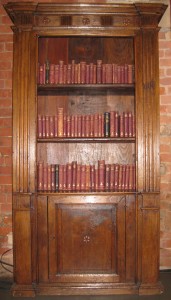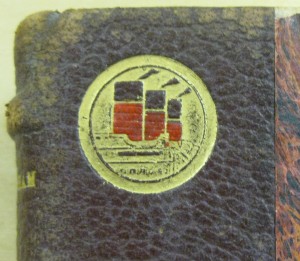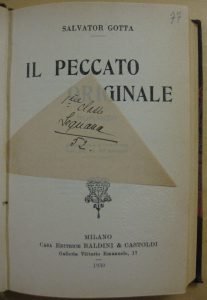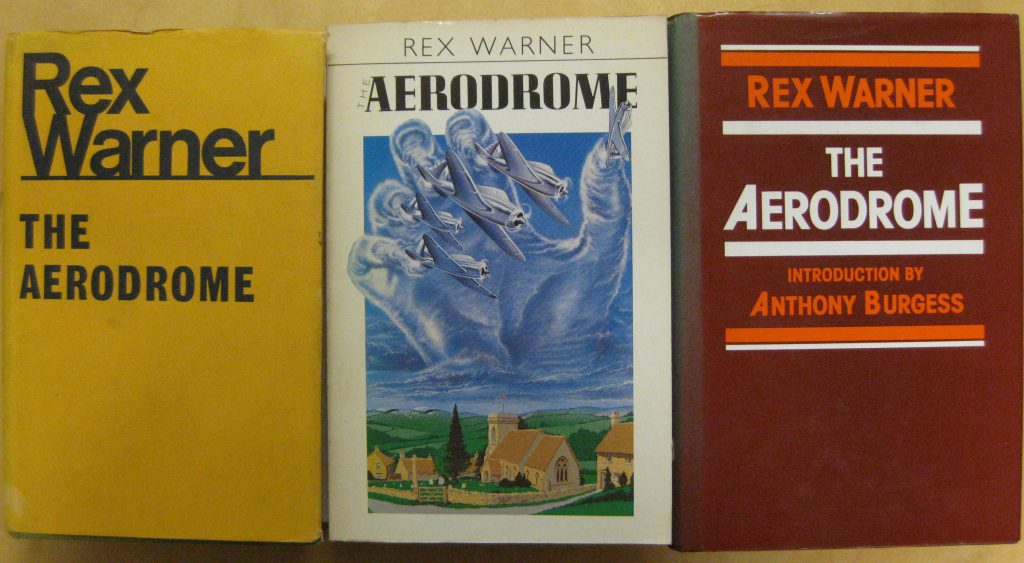Anthony Burgess’s ship’s library
-
Anna Edwards
- 26th August 2015
-
category
- Blog Posts
-
tagged as
- Collections
- Ship's library
- The Aerodrome
On display at the Burgess Foundation is a ‘ship’s library’ of just over one hundred books. Very little is known for certain of its history and provenance, but we have tried to discover as much as we can about this fascinating part of our collection.
The ship’s library consists of a mixture of fiction and non-fiction titles, published between around 1921 and 1938 in capital cities across Europe. Works are primarily in English or Italian, although there are some German titles. Texts in English include first / early editions of novels by popular authors, such as The Summing Up by Somerset Maugham, Flying Colours by C.S. Forester, and Let the Hurricane Roar (later retitled Young Pioneers) by Rose Wilder Lane, along with Major Tom Harrisson’s first book of anthropology, Savage Civilisations, based on the work of Oxford University’s expedition to the New Hebrides between 1933 and 1934. In Italian, there are titles such as Guerra di popolo by Carlo Delcroix, Il Peccati Originale by S. Gotta, and Antologia della letteratura italiana by Attilio Momigliano.
Ship’s libraries provided a popular source of recreation during sea voyages, but their contents would frequently be dispersed as fashions in literature changed, or the ships themselves were decommissioned. This surviving collection offers an insight into popular twentieth century literature in the years preceding World War Two, as well as into general trends in political, social and religious thought during the period. It may have been for these reasons that the library was of interest to Anthony and Liana Burgess; or it may have been kept by them as a decorative object, and as such could be considered among the wider collection of personal effects and household items belonging to Burgess and his immediate family which is now held at the Burgess Foundation. Considered as a whole, these items offer a unique and so far largely unexplored insight into the personal tastes, habits and interests of Burgess and his family. Burgess incorporates several of his possessions into his novels: for example, a camphorwood chest, similar to that owned by Burgess, is used by two of the protagonists to hide a body in One Hand Clapping (1961); Burgess’s Restoration sideboard (c.1685) appears in Inside Mr Enderby (1963); and a William Foster harpsichord (c.1970s) is among Kenneth Toomey’s possessions in Earthly Powers (1980).
So far, it has proved impossible to firmly identify the ship from which the library originated, but it appears to have been a passenger-ship, called the Sequana. A large number of books in the collection contain a small slip of paper on which phrases such as “Touriste Sequana 9”, “1 classe Sequana 52”, “Sequana 80” have been neatly written in an early twentieth century hand. The binding of each book may offer further clues as to the provenance of the collection: each is similarly bound and is embossed with the symbols of an anchor and three red funnels.
Although the Sequana’s library is not mentioned directly in Burgess’s fiction, he recalls his discovery of what was to become one of his favourite novels in just such a ship’s library in his 1982 introduction to Rex Warner’s The Aerodrome: ‘I shall never forget my first reading of The Aerodrome. A thoughtful sergeant-major rather than a corporal, I was being sent home to England from Gibraltar on a derelict ship of French provenance with a monoglot Chinese crew. We slept on the deck and rats jumped over us all night long. Rats also turned up in savoury stews which, along with apple jam in cans the size of petrol drums, formed our three-week diet. There was a small ship’s library and in this I found three, repeat three, hardback copies of The Aerodrome. I stowed one in my kitbag and it became the first item in my post-war library. One of the others I devoured at once; I was, as I had expected, enthralled.’
It seems Burgess’s liberated copy of The Aerodrome no longer survives: editions from 1966 and 1982 form part of the Burgess Foundation’s collection in Manchester, and a 1945 Penguin edition is currently at the Anthony Burgess Centre at the Université d’Angers in France.






